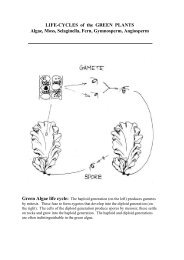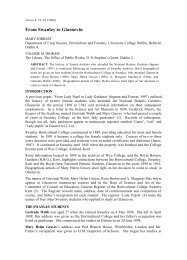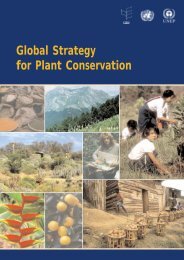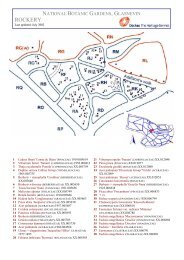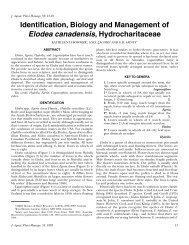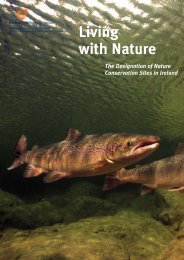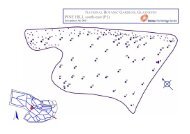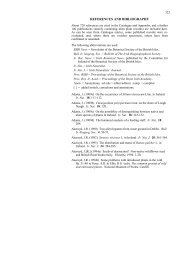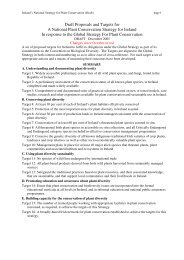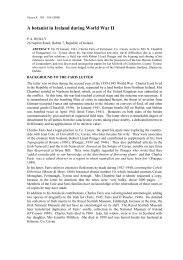Gunnera - Mayo County Council
Gunnera - Mayo County Council
Gunnera - Mayo County Council
- No tags were found...
You also want an ePaper? Increase the reach of your titles
YUMPU automatically turns print PDFs into web optimized ePapers that Google loves.
RemovalRemoval is not recommended as a form of control forlarge plants. However, it is very effective with smallerplants, in particular new seedlings.GUNNERA ISSPREADING ANDDAMAGING OURCOUNTRYSIDE. PLEASEHELP CONTROL THEINVADER!INVASIVE ALIEN PLANTLarge brown rhizomes are a visible feature in the winter<strong>Gunnera</strong> has a rhizome which can easily be broken intopieces that have the potential to re-sprout. Care must betaken not to leave any fragments behind.Once the plants have been removed they must bedisposed of carefully. The rhizomes will not compost,although it is safe to compost the leaves. DO NOT disposeof plants by dumping in another area. Options availableinclude leaving them in a black plastic bag, burning,drying out or deep burial.GIANT RHUBARB(<strong>Gunnera</strong> tinctoria)<strong>Gunnera</strong> is an alien invasiveplant that was first introduced toIreland over 100 years ago. It ispredominantly found in westerncoastal counties. <strong>Gunnera</strong> isspreading rapidly and somethingmust be done.For further information:www.mayococo.ie/heritagewww.invasivespeciesireland.comAn action of the <strong>County</strong> <strong>Mayo</strong> Heritage Plan 2006–2011The aim of this leaflet is to provideinformation on the damaging effects ofthis plant and the methods that can beused to control it.
WHERE HAS GUNNERA COME FROM?<strong>Gunnera</strong> tinctoria is a plant native to South America. Itwas introduced to Ireland over 100 years ago, possibly asan ornamental plant. Its natural habitat has very similarclimatic conditions to those found in the west coast ofIreland.In the west of Ireland, <strong>Gunnera</strong> is predominant alongroadsides and waterways, on coastal cliffs and disusedfarmlands and quarries.<strong>Gunnera</strong> tinctoria growing between heather and along a river.WHAT DOES IT LOOK LIKE?<strong>Gunnera</strong> is a large herbaceous plant that forms densecolonies. It can grow up to 2 meters in height. It has largeleathery umbrella-shaped leaves, with spikes on the backof the leaves and along the stems. The size of the leavesand their early spring emergence prevent native plantsfrom germinating or growing due to shading. Despite itssimilar appearance, <strong>Gunnera</strong> is not related to rhubarb.The plant has a large rhizome, which can grow up to 2meters in length along the ground. The rhizome is thevisible stump which is exposed when the leaves die backin winter.<strong>Gunnera</strong> can resprout from tiny fragments of the rhizomeand can reproduce by seed; each flower head can produceover 250,000 seeds a year. This allows the plant to spreadrapidly and makes it difficult to eradicate.<strong>Gunnera</strong> tinctoria<strong>Gunnera</strong> tinctoria seedling growing in gravelLarge fruiting head in flower (left).seeds (right). Seeds turn red/orange when ripe.WHAT CAN YOU DO TO CONTROL IT?Chemical ControlTo date trials have taken place using herbicides containingglyphosate i.e. RoundUp. Success has been achieved bothhere in Ireland and in New Zealand.When to apply?Late in the growing season (late Aug/Sept), when theplants are fully grown, before the leaves die back.How much?Using the recommended concentration, thoroughlyspray the leaves on both sides if possible. If the plants arevery close to waterways, or are not possible to spray dueto the size of the plants, the leaves can be cut at the baseand herbicide applied directly to the stumps. Herbicideshould be applied immediately after cutting, with a brushor sponge. It is possible that herbicide will need to bereapplied to larger plants.Remember:Fine weather is necessary for application of herbicides. Ifspraying wait until a calm day to prevent spray drift. Usesafety clothing and a mask when using herbicides. Alwaysfollow the manufacturer’s advice and instructions. If youpropose to spray in lands that are designated for natureconservation i.e. SACs (Special Areas of Conservation),NHAs (Natural Heritage Areas) or SPAs (Special ProtectionAreas) you must seek consent from the National Parksand Wildlife Service (Telephone: Ballycroy 098 49996,Connemara 095 41054).<strong>Gunnera</strong> applied with RoundUp (left). Blue dye to showherbicide applied using Cut and Paint technique (right).



